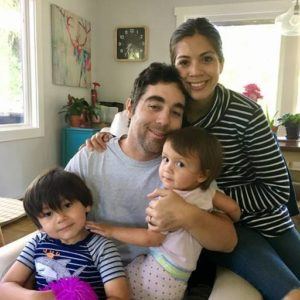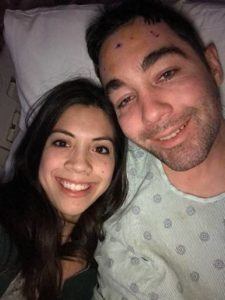
Ivy Blog
A GBM Diagnosis and Journey to Barrow
- July 12, 2019
- Abby Cooper
- Posted in Patient Stories

My husband Ian is a planner. So much so, that we joke about how thoroughly he contemplates every option and once his mind is made up, it is (stubbornly) set. As we make big and small plans for our family, Ian’s thoughtful decisiveness is my compass. But two years ago, we were thrown an obstacle that changed the course of the life we had planned together.
We were raising our family in Anchorage, Alaska and our children were seven months old and two years old– that sweet age, equal parts exhausting and wonderful. On April 22, 2017, Ian was at home with his mom and our children, when he suddenly felt strange and couldn’t say the words he was looking for. His mom called 911. In the ambulance, Ian had two severe seizures. After scans and tests in the ER, doctors found a large mass in the speech center of his brain.

Ian had a craniotomy at our local hospital. Two days later, the pathology confirmed the tumor was glioblastoma, or GBM, the most aggressive form of brain cancer. “I don’t understand, he’s only 30,” is all I could say to his neurosurgeon. Afterward, I crawled in the hospital bed next to my husband and cried. Our world flipped as Ian recovered from surgery and bravely began treatment. While he focused on staying strong through radiation and six months of chemo, I learned what I could about the disease.
The median survival is 15 months. Nine out of 10 people diagnosed won’t survive five years. Even if treatment is effective, a tumor almost always returns.
What’s worse, survival rates for GBM have shown no notable improvement in the last three decades. The standard of care is surgery, chemotherapy and radiation, but it’s only palliative. Treatment success is measured in months. Navigating this disease is like playing a disappointing game of Would You Rather, knowing the outcome is almost always the same. More radiation or a second surgery? Another chemotherapy or a clinical trial? The decisions are endless and our search for effective therapies has taken us all over the country.

In December 2018, we moved our family from Alaska to Arizona because we knew Ian needed to be treated at a major brain tumor center. Barrow Neurological Institute in Phoenix treats more brain tumor patients than any other medical center in the U.S. and recently established the Ivy Brain Tumor Center, the largest Phase 0 clinical trial program in the world.
By testing drug combinations matched to a patient’s tumor, Phase 0 clinical trials save patients valuable time. Instead of waiting months to know if a drug is working, drug effects on a patient’s tumor are measured within days of surgery. This innovative program benefits patients right now and accelerates brain tumor research that could contribute to a cure.
Throughout this journey, we’ve prayed countless prayers. We’ve accepted that not everything is in our hands but we also believe nothing is impossible. Ian is beating the statistics and outliving his initial prognosis. We are immensely grateful. But two brain surgeries, radiation and three types of chemotherapy have a significant physical and neurological toll. Ian is beyond courageous and continues treatment, including speech and physical therapy at Barrow. We have more tough decisions ahead and are relieved to know a Phase 0 trial might be an option for Ian, should he need it.
While I haven’t personally experienced cancer, I have walked alongside my husband every step of his journey. The past two years as a wife, a mother and caregiver have been a rollercoaster of tears, prayer, education, frustration, worry and hope. I know how desperately patients and their loved ones are waiting for a cure. My family is waiting too. We need brain tumor research that disrupts the status quo, and quickly. For now, we have hope Ian will be here for many more big and small milestones as a husband and father. In fact, we are planning on it.
This story is for general health information only and is not meant to be used as medical advice, diagnosis or treatment. Please consult your physician or healthcare provider before beginning any treatment protocol or with any questions. This story reflects the health status of this particular patient at the time the story was written and photographs were taken. The patient’s condition may have changed over time.
